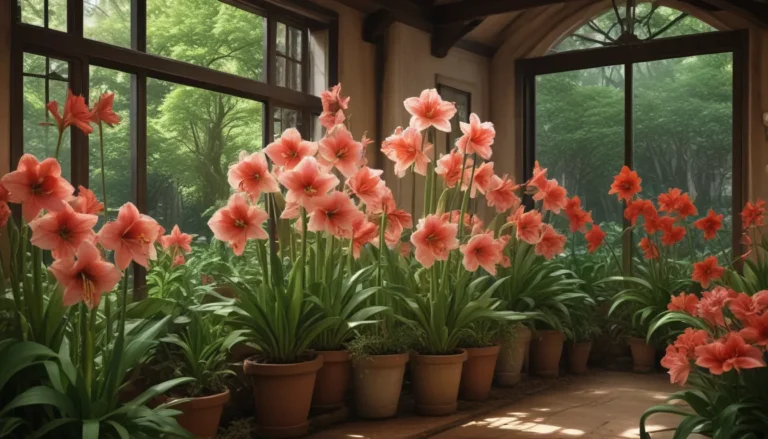Ultimate Guide: How to Prepare and Store Bulbs for Winter

As the gardening season draws to a close, it’s time to start thinking about how to take care of your plants and prepare bulbs for winter. Flowering bulbs are a delightful addition to any garden, bringing beauty and color throughout the seasons.
Whether you have spring-flowering alliums, crocuses, and daffodils or summer-blooming begonias, dahlias, and lilies, knowing how to care for these beauties during the winter months is essential for their health and longevity.
In this comprehensive guide, we’ll delve into the world of bulbs, discussing the different types, how to properly prepare them for winter, step-by-step instructions on lifting, cleaning, and storing, storage conditions and locations, and much more!
So, grab your gardening gloves and let’s get started!
What Are Bulbs?
Bulbs are underground storage organs that remain dormant during the winter months, containing the developing foliage and buds that will bloom in the upcoming growing season. These remarkable structures contain everything necessary for future growth, including roots, stems, flowers, and seeds.
Most plants that produce bulbs are perennials, surviving dormancy by storing water and nutrients in these fleshy underground sections. Tender varieties of bulbs, such as dahlias and gladiolus, are more susceptible to freezing temperatures and require special care during the winter months.
In-Ground Overwintering
Hardy varieties of bulbs, such as tulips and snowdrops, can survive cold winter soil and do not require extensive winter care. They can be left in the ground during the winter months, but adding a layer of mulch for protection is recommended in regions with regular freeze-thaw cycles.
If you are gardening in containers, providing extra protection with a layer of mulch is beneficial during the coldest part of the year. Remember to remove the mulch once shoots begin to emerge in the spring.
Lifting hardy varieties in the fall for rejuvenation or dividing is also an option for many gardeners, as it allows for easier replanting in the spring.
Lift, Clean, and Dry
When preparing tender varieties of bulbs for winter storage, follow these steps:
- Dig up the bulbs after the foliage has wilted but before the first frost.
- Trim any remaining foliage to four to six inches in length.
- Gently pry up the root ball with a garden fork or spade, removing any excess soil.
- Loosen, shake, or brush away clumps of soil clinging to the roots.
- Remove damaged or soft parts with a sharp knife.
- Allow the roots to air dry for one to three weeks in a warm, dry location with good air circulation.
- Do not wash the rootstock, as excess moisture can lead to rot.
Once the bulbs are thoroughly dry, brush off any remaining dirt and dust them with a fungicide before packing for storage.
Pack and Store
To store bulbs properly, use a breathable medium that allows for air circulation:
- Use ventilated cardboard boxes, mesh bags, paper bags, or wooden bins.
- Label each container to avoid confusion.
- Add a thin layer of airy material like shredded newspaper or peat moss.
- Place bulbs in a single layer, ensuring they are not touching.
- Cover with the packing medium to a depth of two to three inches.
- Do not add a lid, as it can trap moisture and cause mold.
- Move the packed containers to a cool, dark, and dry location for winter storage.
Storage Conditions and Location
Most tender bulbs require an average temperature of about 40°F during the dormant period, while some may prefer temperatures in the low 60s. Choose a location like a basement, cellar, garage, or shed that provides the right conditions for your bulbs.
For hardy, spring-flowering varieties that require vernalization before blooming, consider storing them in the refrigerator for at least eight weeks.
Monthly Spot-Checks
To ensure the health of your bulbs during storage, perform monthly spot-checks. Discard any bulbs that have become soft, mushy, or smelly to prevent the spread of rot.
Divide and Plant
When it’s time to plant your bulbs in the spring, follow these steps:
- Inspect each bulb for health before planting.
- Discard any bulbs that are mushy, shriveled, or soft.
- Divide smaller bulbils or offsets from larger parent bulbs before planting.
- Plant tender, summer-flowering bulbs after the last frost date.
- Plant hardy, spring-flowering varieties as soon as the ground thaws.
By following these steps, you can ensure that your bulbs stay healthy during the winter months and bloom beautifully in the spring.
Conclusion
Preparing and storing bulbs for winter is essential for the health and longevity of these beautiful plants. By following the steps outlined in this guide, you can protect your bulbs from freezing temperatures and ensure they bloom vibrantly for years to come.
If you have any questions or need further information on storing bulbs, feel free to drop us a note in the comments section below. And be sure to check out our other guides on bulb propagation and viability testing for more gardening tips and tricks.
Happy gardening!





